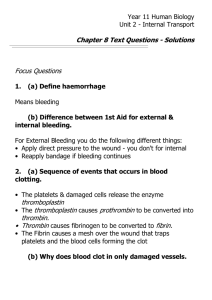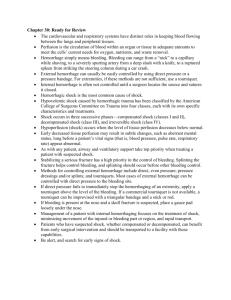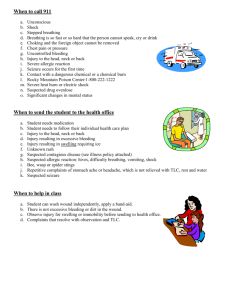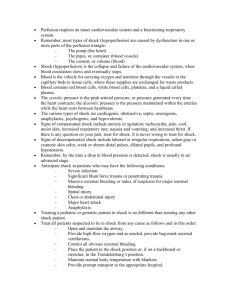Bleeding and Shock
advertisement
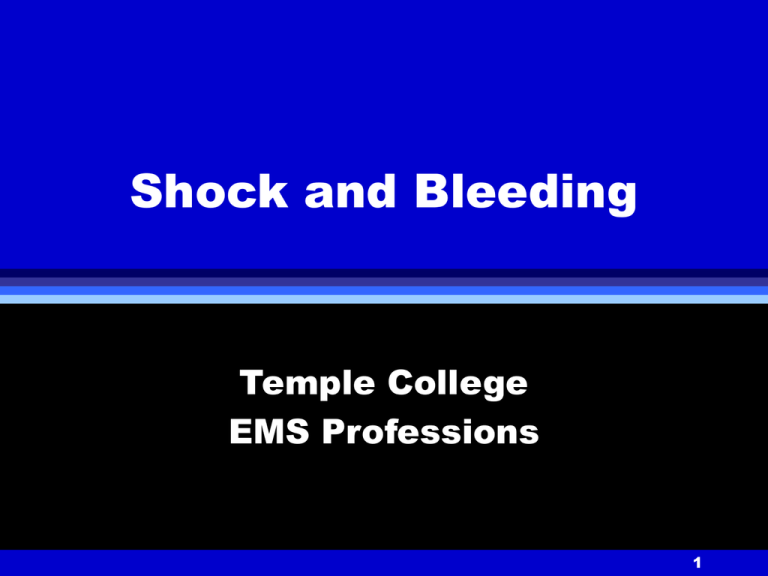
Shock and Bleeding Temple College EMS Professions 1 SHOCK Inadequate perfusion (blood flow) leading to inadequate oxygen delivery to tissues 2 Physiology Basic unit of life = cell Cells get energy needed to stay alive by reacting oxygen with fuel (usually glucose) No oxygen, no energy No energy, no life 3 Cardiovascular System Transports oxygen, fuel to cells Removes carbon dioxide, waste products for elimination from body Cardiovascular system must be able to maintain sufficient flow through capillary beds to meet cell’s oxygen and fuel needs 4 Flow = Perfusion Adequate Flow = Adequate Perfusion Inadequate Flow = Indequate Perfusion (Hypoperfusion) Hypoperfusion = Shock 5 What is needed to maintain perfusion? Pump Heart Pipes Blood Vessels Fluid Blood 6 How can perfusion fail? Pump Failure Pipe Failure Loss of Volume 7 Types of Shock and Their Causes 8 Cardiogenic Shock Pump failure Heart’s output depends on • How often it beats (heart rate) • How hard it beats (contractility) Rate or contractility problems cause pump failure 9 Cardiogenic Shock Causes • Acute myocardial infarction • Very low heart rates (bradycardias) • Very high heart rates (tachycardias) Why would a high heart rate caused decreased output? Hint: Think about when the heart fills. 10 Neurogenic Shock Loss of peripheral resistance Spinal cord injured Vessels below injury dilate What happens to the pressure in a closed system if you increase its size? 11 Hypovolemic Shock Loss of volume Causes • Blood loss: trauma • Plasma loss: burns • Water loss: Vomiting, diarrhea, sweating, increased urine, increased respiratory loss If a system that is supposed to be closed leaks, what happens to the pressure in it? 12 Psychogenic Shock Simple fainting (syncope) Caused by stress, pain, fright Heart rate slows, vessels dilate Brain becomes hypoperfused Loss of consciousness occurs What two problems combine to produce hypoperfusion in psychogenic shock? 13 Septic Shock Results from body’s response to bacteria in bloodstream Vessels dilate, become “leaky” What two problems combine to produce hypoperfusion in septic shock? 14 Anaphylactic Shock Results from severe allergic reaction Body responds to allergen by releasing histamine Histamine causes vessels to dilate and become “leaky” What two problems combine to produce hypoperfusion in anaphylaxis? 15 Shock: Signs and Symptoms Restlessness, anxiety Decreasing level of consciousness Dull eyes Rapid, shallow respirations Nausea, vomiting Thirst Diminished urine output Why are these signs and symptoms present? Hint: Think hypoperfusion 16 Shock: Signs and Symptoms Hypovolemia will cause • Weak, rapid pulse • Pale, cool, clammy skin Cardiogenic shock may cause: • Weak, rapid pulse or weak, slow pulse • Pale, cool, clammy skin Neurogenic shock will cause: • Weak, slow pulse • Dry, flushed skin Sepsis and anaphylaxis will cause: • Weak, rapid pulse • Dry, flushed skin Can you explain the differences in the signs and symptoms? 17 Shock: Signs and Symptoms Patients with anaphylaxis will: • Develop hives (urticaria) • Itch • Develop wheezing and difficulty breathing (bronchospasm) What chemical released from the body during an allergic reaction accounts for these effects? 18 Shock: Signs and Symptoms Shock is NOT the same thing as a low blood pressure! A falling blood pressure is a LATE sign of shock! 19 Treatment Secure, maintain airway Apply high concentration oxygen Assist ventilations as needed Keep patient supine Control obvious bleeding Stabilize fractures Prevent loss of body heat 20 Treatment Elevate lower extremities 8 to 12 inches in hypovolemic shock Do NOT elevate the lower extremities in cardiogenic shock Why the difference in management? 21 Treatment Administer nothing by mouth, even if the patient complains of thirst 22 Bleeding 23 Bleeding Significance If uncontrolled, can cause shock and death 24 Identification of External Bleeding Arterial Bleed • Bright red • Spurting Venous Bleed • Dark red • Steady flow What is the physiology that explains the differences? Capillary Bleed • Dark red • Oozing 25 Control of External Bleeding Direct Pressure • gloved hand • dressing/bandage Elevation Arterial pressure points 26 Arterial Pressure Points Upper extremity: Brachial Lower extramity: Femoral 27 Control of External Bleeding Splinting • Air splint • Pneumatic antishock garment 28 Control of External Bleeding Tourniquets • • • • Final resort when all else fails Used for amputations 3-4” wide write “TK” and time of application on forehead of patient • Notify other personnel 29 Control of External Bleeding Tourniquets • Do not loosen or remove until definitive care is available • Do not cover with sheets, blankets, etc. 30 Epistaxis Nosebleed Common problem 31 Epistaxis Causes • • • • • • Fractured skull Facial injuries Sinusitis, other URIs High BP Clotting disorders Digital insertion (nose picking) 32 Epistaxis Management • • • • • • Sit up, lean forward Pinch nostrils together Keep in sitting position Keep quiet Apply ice over nose 15 min adequate 33 Epistaxis Epistaxis can result in lifethreatening blood loss 34 Internal Bleeding Can occur due to: • • • • Trauma Clotting disorders Rupture of blood vessels Fractures (injury to nearby vessels) 35 Internal Bleeding Can result in rapid progression to hypovolemic shock and death 36 Internal Bleeding Assessment • Mechanism? • Signs and symptoms of hypovolemia without obvious external bleeding 37 Internal Bleeding Signs and Symptoms • Pain, tenderness, swelling, discoloration at injury site • Bleeding from any body orifice 38 Internal Bleeding Signs and Symptoms • Vomiting bright red blood or coffee ground material • Dark, tarry stools (melena) • Tender, rigid, or distended abdomen 39 Internal Bleeding Management • • • • • • Open airway High concentration oxygen Assist ventilations Control external bleeding Stabilize fractures Transport rapidly to appropriate facility 40

